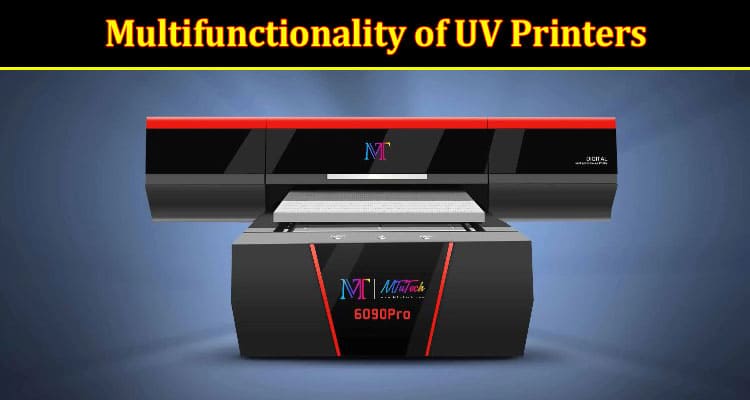In an era where customization is key, UV printing technology is making significant strides. The UV Flatbed Printer, for instance, is redefining the printing world with its incredible versatility. This article seeks to explore the multifunctionality of UV printers, including the UV Flatbed Printer, as they can print on much more than just paper.
What is UV Printing?
Before we delve into the plethora of possibilities, it’s essential to understand what UV printing entails. UV printing is a digital printing method that uses ultraviolet light to dry or cure ink almost instantaneously. This ensures that the ink doesn’t spread or smudge, making it possible to print on a wide variety of surfaces, not just paper.
The UV Flatbed Printer
The UV Flatbed Printer is a variant that is particularly popular for its ability to print on unconventional and rigid materials. It has a flat surface where the printing material is placed, and the print head moves over the material to render the image. Since it uses UV curing technology, it can print on surfaces where traditional ink would not adhere. This brings us to the wide array of substrates that UV flatbed printers can tackle.
Beyond Paper – The Range of Substrates
- Plastics and Acrylics
UV printing allows for direct printing on plastics and acrylics. Whether it is signage, decorative panels, or custom branded products, the UV Flatbed Printer does it with precision and vivid color representation.
- Wood
One of the more surprising materials for many is wood. From personalized wooden plaques to custom furniture panels, UV printers can render intricate designs on wood, giving an authentic and premium feel to the products.
- Glass and Ceramics
Whether it’s beautiful glassware or ceramic tiles, UV printing can be employed to produce custom designs. Especially in interior décor, custom tiles are becoming increasingly popular.
- Metals
Metal is another material that can be used with UV printers. Custom metal business cards, signage, and even personal items like flasks or metal phone cases can be printed with ease.
- Textiles and Apparel
UV DTF (Direct to Film) is a technology that is transforming the apparel industry. With UV DTF, designs can be printed on a special film which is then transferred to the fabric. This ensures high-quality, durable prints on various types of textiles.
- Leather and Synthetic Materials
Beyond the conventional materials, UV printing can also be effectively used for printing on leather and synthetic materials. Customized wallets, bags, belts, and even book covers can be printed with personal designs. This adds a touch of personalization to leather products which is highly valued in the fashion and accessories market.
- Electronic Gadgets and Accessories
In the modern world, electronic gadgets are not just tools; they are a part of one’s identity. UV printers allow customization of gadgets such as laptops, smartphones, and their accessories like phone cases and skins. The ability to print on uneven surfaces ensures that even the most complex designs adhere flawlessly.
- Building Materials
UV printers can also print on building materials such as bricks, marbles, and stones. This opens up opportunities for customization in construction and landscaping. Think of a wall with a customized brick pattern or a kitchen countertop with a unique design imprinted on the marble.
- Packaging Materials
In an age where unboxing experiences are shared on social media, packaging plays an essential role in a product’s appeal. UV printing allows businesses to create custom packaging, adding vibrant colors and intricate designs to boxes and wrappers.
- Musical Instruments
Music artists often seek ways to make their instruments unique. UV printers enable customization of musical instruments like guitars, drums, and piano covers. This not only personalizes the instrument but can also serve as a branding element for the artist.
Environmental Benefits
Besides the multifunctionality, UV printing is also known for being more environmentally friendly compared to traditional printing methods. Since the inks are cured and dry almost instantly, there are fewer emissions and less waste produced.
Innovation and Future Prospects
UV printing technology continues to evolve with the advancement of materials science and digital imaging. Innovative inks that can adhere to even more diverse materials are being developed. The future may see UV printers capable of printing on materials that we can’t even imagine today. Additionally, as 3D printing evolves, there could be a convergence of UV and 3D printing technologies, leading to entirely new applications and functionalities.
The Role of UV Printers in Customization Trends
With personalization being a dominant trend in consumer markets, UV printers play a critical role. They offer an opportunity for businesses to provide personalized products, which can be a key differentiator in a saturated market. Moreover, for artists and designers, UV printing opens the doors to new mediums and materials, allowing them to push the boundaries of their creativity.
Final Words
UV printers, especially the UV Flatbed Printer, are transforming the way we think about printing. With the ability to print on a wide array of materials ranging from paper to metals, textiles, and even building materials, they offer limitless possibilities. Their environmental benefits are an added advantage in an increasingly eco-conscious world. As technology advances, UV printing will undoubtedly continue to grow in its applications and significance. Embracing this technology can be an excellent step for businesses, artists, and individuals seeking to make their mark in a world where customization is king.

